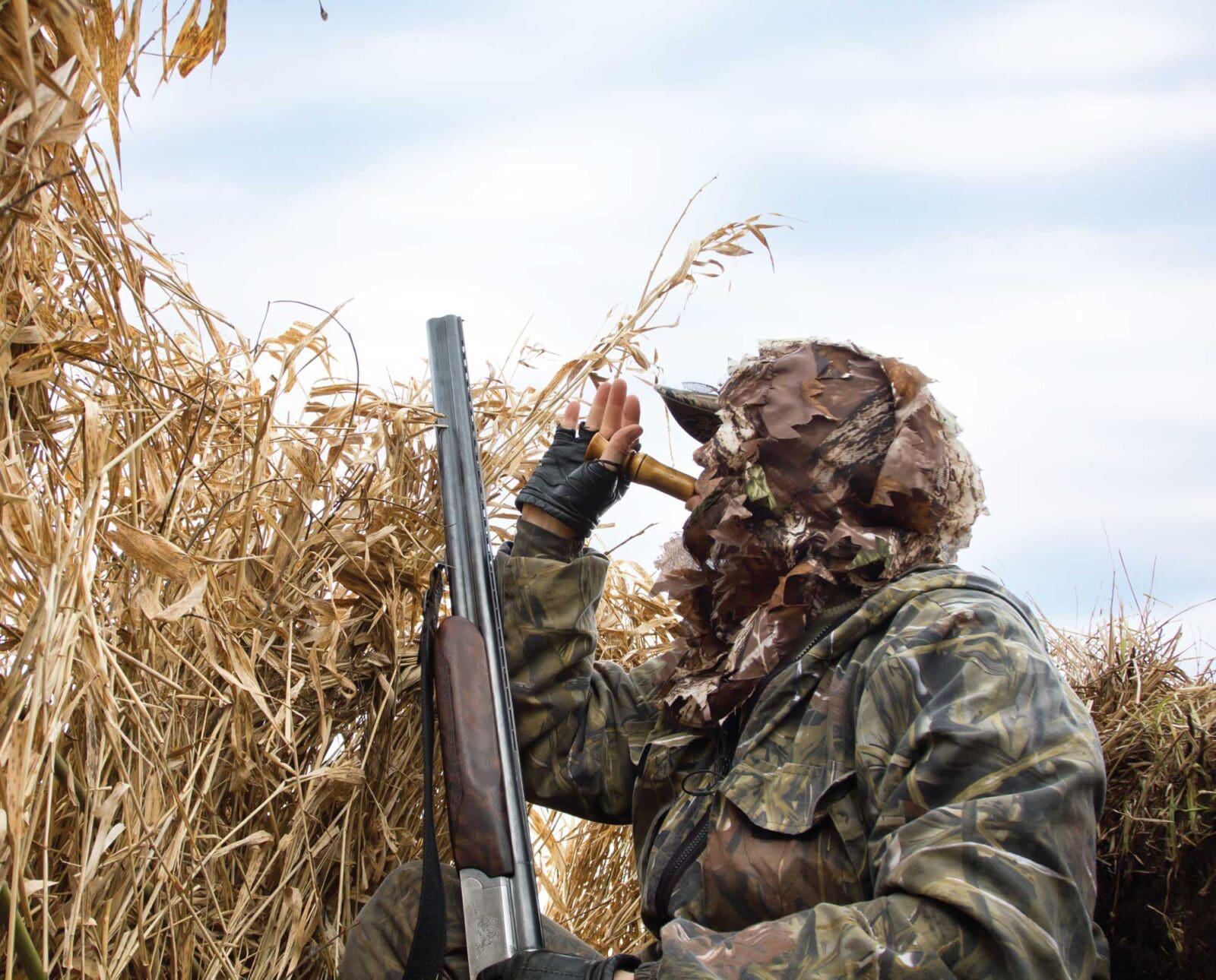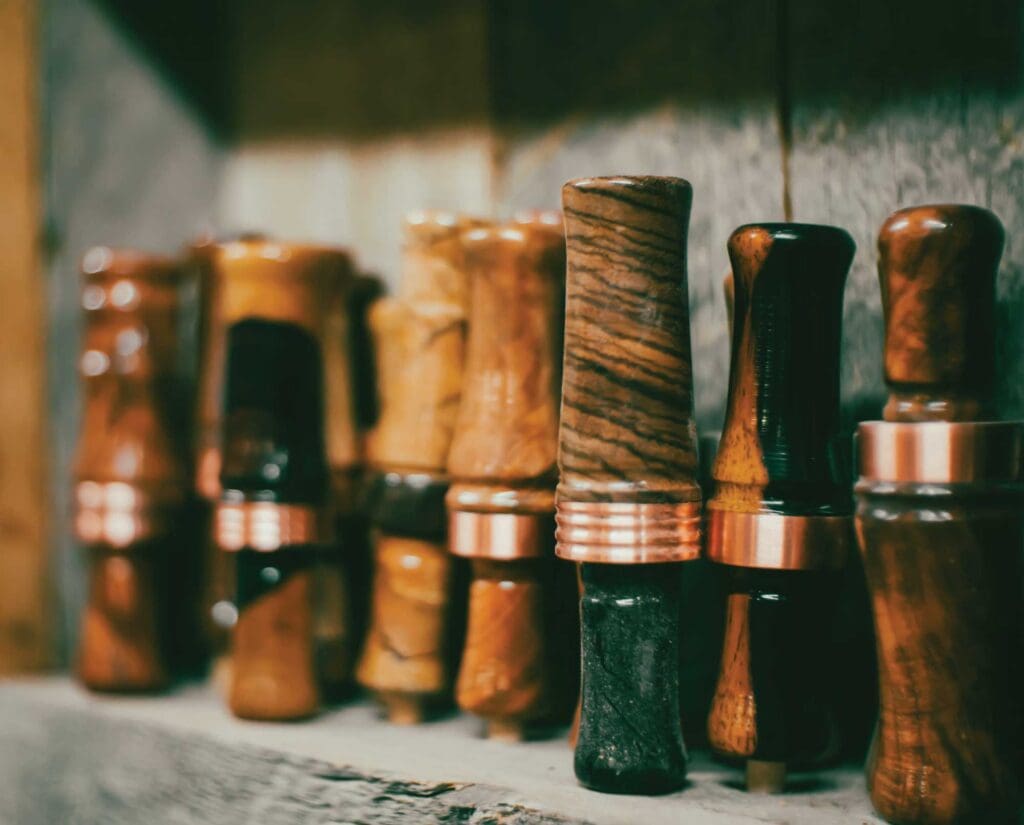Home » Waterfowl Hunting » Tips for Better Duck Calling
Tips for Better Duck Calling

Mike Adams is an outdoor writer, wildlife biologist, and educator…
Learn how to increases your duck hunting chances with these basic tips in duck calling skills for this hunting season
My old man made duck calling look easy. He’d take a thirty-year-old, single-reed duck call caked in gray mud and turn birds around from the other side of the marsh. However, his grandfather preferred the old-school method. When my dad was ten, his grandfather quacked and hummed at a lone mallard drake by hand and mouth only on an icy, briny creek. That bird became the first duck my dad ever shot. Hearing those stories and watching my dad use a call as effortlessly as a chef using a knife, I got the impression that duck calling was easy. But when I picked up my first duck call in high school and tried to teach myself how to use it, it sounded like a kazoo.
It took my entire senior year to get it right. I’d play recordings of mallards over my car’s stereo system. I mimicked the sounds with my double-reed Echo call, which I kept slung over my rearview mirror with a lanyard. I’d rip hail calls at stop lights and let quacks form a symphony on the highway. Pedestrians rubbernecked at the cacophony of croaks and purrs, whistles and chatter coming from my car. I looked like a duck-hunting fool to my friends who wanted to listen to the radio. Yet none of that mattered because, by graduation, I had finally learned how to use a duck call the right way.
It took several more years to actually become a good duck caller; that’s tough. Matching your duck call to the same cadence, tone, pitch, and crescendo as real ducks are one thing. Putting it all together in a way that fools wild birds is a much bigger chore. The trick is bridging the gap between making duck sounds and speaking duck language. You can sound like a duck, but unless you can speak with them, you might as well leave the call at home. Luckily for us, learning duck speech isn’t all that hard, and in terms of hunting, it can be broken down into five simple core principles.
Choose the Right Duck Call
Duck hunters preach so much about choosing the right duck call that it’s become a cliche. Of course, choosing a good duck call is important, but what does that mean? Truthfully, it’s not all that complicated. The right duck call needs to sound like a duck, and there are two ideal sources you can turn to when figuring out which calls work best: nature and science.
Nature will tell you the cadence and tone of duck calls. Lousianian duck hunters know this well. Ducks on the Gulf Coast are gluttons, and when female dabblers call at incoming birds, they rarely produce the sharp and concise tones typical of other parts of the country. Instead, these birds talk with their mouths full of grain, and their calls squeak. Hunters call it the Cajun Squeal, and it’s basically a hail call with subtle squeaks marking the end of each note. To make a sound like the Cajun Squeal, some companies like Haydel’s Game Calls have created calls specifically to mimic that higher pitch.
Most folks don’t need to go out of their way to find a call tailored to their local ducks’ dialect. The tone and pitch of a typical duck call are predictable and easily imitated with quality calls. Today, we’re inundated with models ranging from single reeds to triple reeds, different lengths and bore diameters, and diverse barrel materials such as acrylic to exotic woods. Duck hunters have their preferences, but a 2013 research paper aimed to put the debate to rest: what kind of duck call sounds most like a duck?
The researchers compared the vocalizations of hen mallards to 38 duck callers who used single and double reed calls crafted of various kinds of wood and casted acrylic. The researchers found that calls made of more rigid, denser materials, with a double reed insert, sounded most like a mallard hen. Of those studied, the researchers identified cocobolo, osage orange, pecan, and bocote wood as the best materials. Among the top rankings of calls, acrylic came in at number 5.

When selecting a duck call, choose based on the accuracy of tone, pitch, and volume to real live ducks. Once your call is picked, it’s time to focus on mastering the language.
Learn the Vocabulary of Ducks for Calling
Before becoming bilingual in duck chatter, you need to learn the vocabulary. Vocab class occurs in the field, and the process begins exactly like how you learn to set up a natural decoy spread. Sit in the blind, go out to the marsh, lake, or duck creek, and pick up cues from wild birds. A few things about duck language become apparent if you listen long enough.
Ducks leaving a body of water tend to belch a sequence of single quacks. Using a series of single quacks in quick succession would be a mistake when mimicking a bird on the water. Conversely, content birds loafing on the water often emit a single quack without any follow-up. That makes a lone single quack or single quacks separated by intervals of a few seconds a good choice for small decoy spreads. Ducks emit a rolling chuckle, usually called a feeder call, in two instances: dabbling on a food source and flying at dawn or dusk towards a feeding or loafing area. Waterfowlers can use chuckles to imitate birds on a food source, but using the feeder call when hunting loafing areas would be unwise. Female dabbling ducks of most species use the decrescendo call to attract other birds. This is called the hail call, often stimulating other hens in the flock to decrescendo. You can imitate them by letting your hail calls cascade like dominos, or emitting two or three hail calls quickly. That technique works best with a buddy, where each hail call rolls into the next.
Master the Single Quack with a Duck Call
There’s a hot topic debate among the duck hunting community about which call better seals the deal for stooling birds: the single quack or the feeder call. In my experience, the single quack takes the cake.
Single quacks mimic content birds. It’s a simple call, and because it’s not as flashy or complicated as calls like the feeder or hail call, it’s often overlooked by hunters. In the late duck season, subtlety becomes crucial, which makes the single quack an ideal call choice.
Waterfowlers can use single quacks in several ways. First, it can be used as a finisher. When birds circle your decoy spread, keeping them hooked is essential. Space out single quacks by several seconds. This sounds like a duck in your decoy spread saying, “Hey, it’s not so bad down here, and we plan to hang out for a while.” In that manner, the single quack can become deadly.
Single quacks can also be used as an enticement call to replace the hail call. Many internet articles will hold the hail call in high esteem for its power in persuading flying birds but pressured ducks pick up on that trick quickly. Separate yourself from other hunters by using the single quack at fly-by ducks. To wild ducks, this can sound more natural, and it can also make your decoy spread more enticing. Again, space out single quacks by several seconds to avoid sounding like an alert bird or a bird leaving the water.
Keep Duck Calling Realistic
Thus far, we’ve been talking about duck calls in the context of common dabbling species, like mallards, black ducks, gadwall, and mottled ducks. But what if you’re hunting a mudflat filled with teal or a bay marsh loaded with pintail?
Nearly every duck hunter owns a call that can quack, but always keep a whistle call handy. With a dynamic whistle call, you can imitate other species of ducks, including teal, widgeon, pintail, and drake mallards. Wood ducks have their own style of duck call, designed explicitly for their iconic “too-weet” cry. Stringing both a whistle call and a standard duck call on your lanyard allows you to imitate a dynamic decoy spread containing various species of ducks. The more natural it looks and sounds, the better the hunting will be.
It’s also important to use appropriate calls at appropriate times. If you have six ducks in your decoy spread, keep calling to a minimum. If you’re hunting over several dozen decoys, you can get away with quite a bit more calling. If you’re hunting a feed area, throw in some duck chatter, and if you’re hunting a loafing area, stick to the standard quack, hail call, and species-specific whistles.
Don’t Be Afraid to Put the Call Down
Duck calls can be as harmful as they are effective. Too often, new or eager hunters find themselves relying on their call, yelling and screeching at ducks from a mile away, or even worse, wailing out hail calls at ducks that are stooling into their decoys. Few things can be steadily relied on in duck hunting, but the fact that overcalling scares smart ducks always holds true.
Duck calls perform as a tool. They are used to make your decoy spread appear more real – nothing more and nothing less. Duck calls won’t work without decoys, but decoys will work without the duck call. Most wild ducks land into flocks that hardly make a peep. When hunting gets tough, especially in the late season, don’t be afraid to put the call down altogether. Come January, I often find myself tucking my calls inside my coat pocket. It helps me avoid the temptation of talking to ducks that don’t want to be talked to, and it’s probably saved more hunts than it’s hurt.
Mike Adams is an outdoor writer, wildlife biologist, and educator hailing from salt marshes of the mid-Atlantic. His work has appeared in numerous outdoor publications, where he uses hunting and fishing narratives to explore deeper issues in conservation or ecology. In the fall, you'll find him on his Barnegat Bay Sneakbox hunting ducks with his dog, Boone. Any other time of year, he's usually out on the salt marsh, catching crabs or fishing for striper.



